Learn the benefits and disadvantages of cast iron cookware.
If you enjoy cooking, you might decide it is time to buy your first piece of cast iron cookware. However, before you start using cast iron, it is good to know the pros and cons.
This article is intended for those who are a little hesitant to cook with cast iron. And want to fully understand the benefits and the negative points before purchasing.
Before we start, if you have a few reservations as a first-time user, it is totally understandable. Cast iron cookware is heavy, and many worry about cleaning and maintaining the cookware. However, I believe a good cast iron skillet will do you proud for many years. Also, it only takes a day or two to get used to the weight.
Table of contents
- Seasoning on cast iron cookware.
- Benefits and disadvantages of cast iron.
- The benefit of a good seasoned pan.
- Can you use scrubbers to clean your cookware?
- Thermal benefits.
- Can get from cooking with iron cookware?
- How long does cast iron cookware last?
- Cost benefit of using iron cookware.
- The different ways you can use iron cookware.
- Types of stovetops that are suitable for cast iron cookware.
- The negative points.
- Final thoughts

What are the pros and cons of cast iron? We’ll give you the good and the bad.
So, “What are the pros and cons of cast iron cookware?” I will focus on the advantages and disadvantages of bare or pre-seasoned cast iron. I’m referring to non-enameled cast-iron cookware.
Non-enameled cast iron is often called bare or pre-seasoned cast iron. Although, both types of ironware have some cross-overs, positive and negative points. However, in this article, I will focus on the benefits and disadvantages of regular cast iron.
People have cooked with bare cast iron for centuries and by many different cultures around the world. It has that lovely black seasoned finish that is reminiscent of years past.
Seasoned cast iron
Proud owners of bare cast iron put a layer of seasoning on the cookware to protect the iron from rust and deterioration. This seasoning also has non-stick properties making the cast iron easier to clean.
Seasoning takes oil past the smoke point to form a layer of polymerization on the cookware. It also makes the cast iron, a luscious black color that we all know and love.
Since the innovation of pre-seasoned ironware by the Lodge Manufacturing Company, most cast iron cookware on the market comes pre-seasoned.
This is wonderful for customers as it allows new owners to use their cookware straight away without the hassle and time required to season new cast iron.
If you are looking for a new piece of cookware, I highly recommend cast iron, primarily because it’s the most fun to cook with. However, with all cookware, it’s not perfect. Let’s look at the pros and cons of bare cast iron.
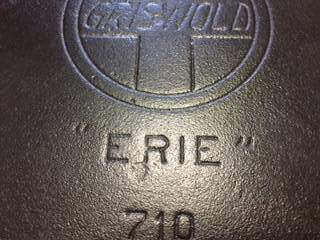
Benefits of cast iron cookware
- Well, seasoned cast iron cookware is easier to clean than stainless steel.
- Cast iron has excellent thermal density. It remains hotter for longer.
- Cooking in cast iron can naturally add iron to your meals.
- Long-lasting. Some families use ironware that is over 100 years old.
- Cheaper than enameled cast iron and high-quality stainless steel cookware.
- Cast iron is durable and is unlikely to break.
Disadvantages of cast iron cookware
- The handle gets hot.
- Cast iron is heavier than other cookware.
- Bare cast iron is not the best for boiling water and cooking acidic foods.
- Cast iron cookware will need re-seasoning.
- Cast iron pans take longer to heat up.
- It’s stronger than kitchen tiles and toes. Ouch, don’t drop it.
Is the seasoning on bare cast iron a positive or a negative?
Seasoning may put a lot of people off cast iron. It can seem a little involved and daunting. However, it’s easy to do, and most cast-iron comes pre-seasoned, so you can use it straight out of the box. Best of all, seasoning slowly builds up over time.
What is the seasoning on cast iron?
Seasoning is oil baked into the pan. And gives the cookware a smooth finish. It also makes pots and pans more non-stick. And protects the cookware from rust because it separates food from the metal surface. Pro.
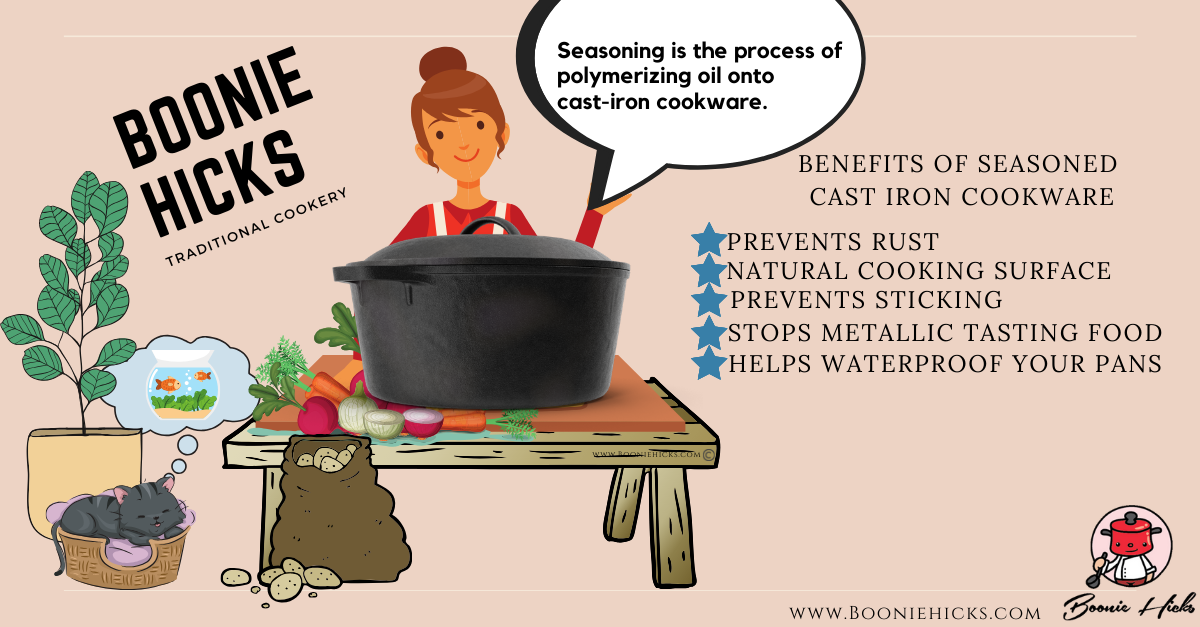
Can I use a scrubbing brush or Scotch-Brite pad on cast iron?
I use a brush and the yellow side of a Scotch-Brite pad with no issues. However, if you like to use a hard scrubber like the green abrasive side of a Scotch-Brite. Or you want to wash your pan in the dishwasher, it is not recommended.
Dishwashers are very good at what they do. Actually too good, using a dishwasher will remove the protective layer of seasoning and cause the cast iron to rust. Con.
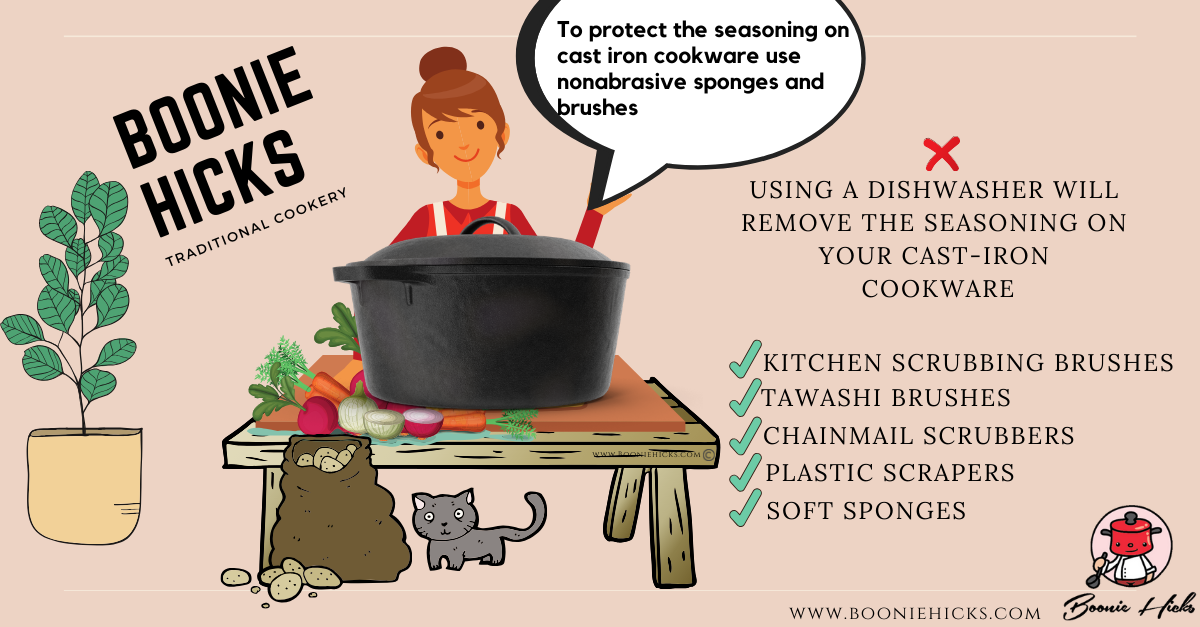
Cast iron will keep food warm while on the table.
Once hot, cast iron remains hot even when taken off the heat source. This is ideal for keeping food hot while preparing other dishes. Those yummy roast potatoes or corn with butter on top will remain hot on the table in cast iron. Big Pro to cast iron.
Cast iron cookware comes in so many sizes.
Manufacturers make a wide range of sizes. Big and small skillets and even dutch ovens for single servings are available. They are great for meals served on the table without taking up to much room or for singles. That’s another Pro.
Iron intake
When cooking in cast iron, the cookware naturally releases iron into your food. This helps to support the daily iron requirements.

The amount released is determined by the acidity in the food and the layer of seasoning on the pan. Seasoning separates food and the bare metal pan. A thick layer of seasoning will release less iron into food.
If you have any questions, have any blood conditions, or take iron supplements, I recommend consulting a doctor or nutritionist before using cast iron cookware. I’m not a medical practitioner. Seek professional advice.
I think it’s better to give a Pro and Con. It really depends on how you feel. For some, added iron is a positive point, and for others, it is negative.
Cast iron cookware lasts a long time.
If you decide on purchasing your first cast iron pan, which I hope you do. It will most likely be the last one you’ll ever need. Some skillets and Dutch ovens from the early foundries are still as usable today as they were when they were first made.
The big names were Griswold and Wagner back in the day. These two foundries made very high-quality cast iron cookware, and they had a very smooth cooking surface. Both Griswold and Wagner are considered some of the best vintage cast iron ever produced and are prized processions by many cast iron collectors.
I can not forget about Lodge. Many pieces over a hundred years in age are still in use today. Here’s another Pro for cast iron cookware.
Since cast-iron cookware is a little thicker and heavier today, it may last even longer. The thinner older pans are more likely to warp or bow under sudden temperature changes. If you have lovely old pots and pans, please pre-heat them for a few minutes first. Benefit for new cast iron.
Is new or vintage pan better? This article discusses the benefits and disadvantages of new and antique cast iron cookware.
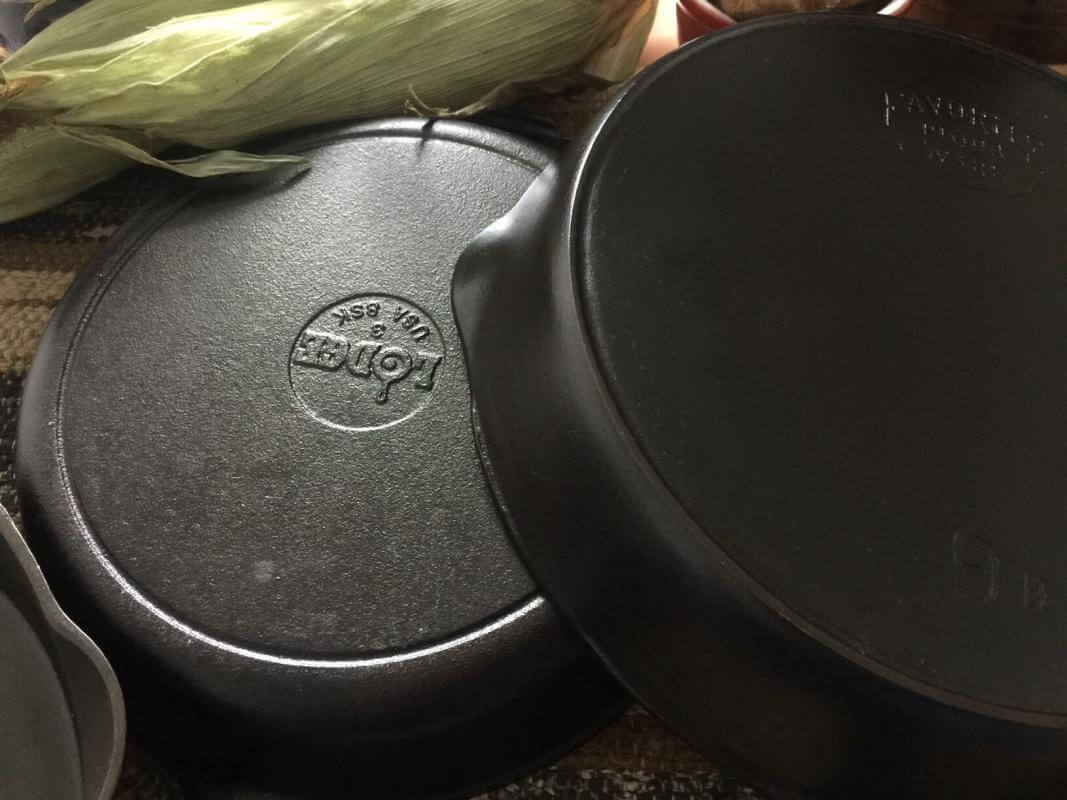
Pre-seasoned cast iron is cheaper than enameled and quality stainless steel cookware.
If you want to know why to use a cast-iron skillet or Dutch oven, there are many reasons. One of the main reasons is it’s going to last a mighty long time and for surprisingly little money.
The versatility of cast-iron cookware is incredible.
This is where cast iron really shines. It’s suitable for so many cooking methods. Bare cast iron can be used for:
- Frying – excellent for pan-frying fish fillets but also deep-fried chicken comes out a lovely golden color.
- Baking – cornbread comes to mind first. However, pastries, desserts, and bread come out wonderfully.
- Searing – your steaks remain juicy in the center and have a lovely caramelized outside to enhance favors. You may even want to consider a grill pan for those barbecue grill marks you’d find at a top restaurant.
- Roasting – you won’t need a dedicated roasting pan to make roast chicken. A skillet or dutch oven is going to do just as well.
- Slow cooking – a French/Dutch oven is excellent for slow cooking. Cast iron heats up slowly and can be left on at a low temperature, either on the stovetop or oven.
- Sauteed vegetables – with a piece of butter then served directly on the table for family and friends to help themselves.
- Outdoor or camping trips – it’s so much fun, and everything tastes better when cooked outdoors.
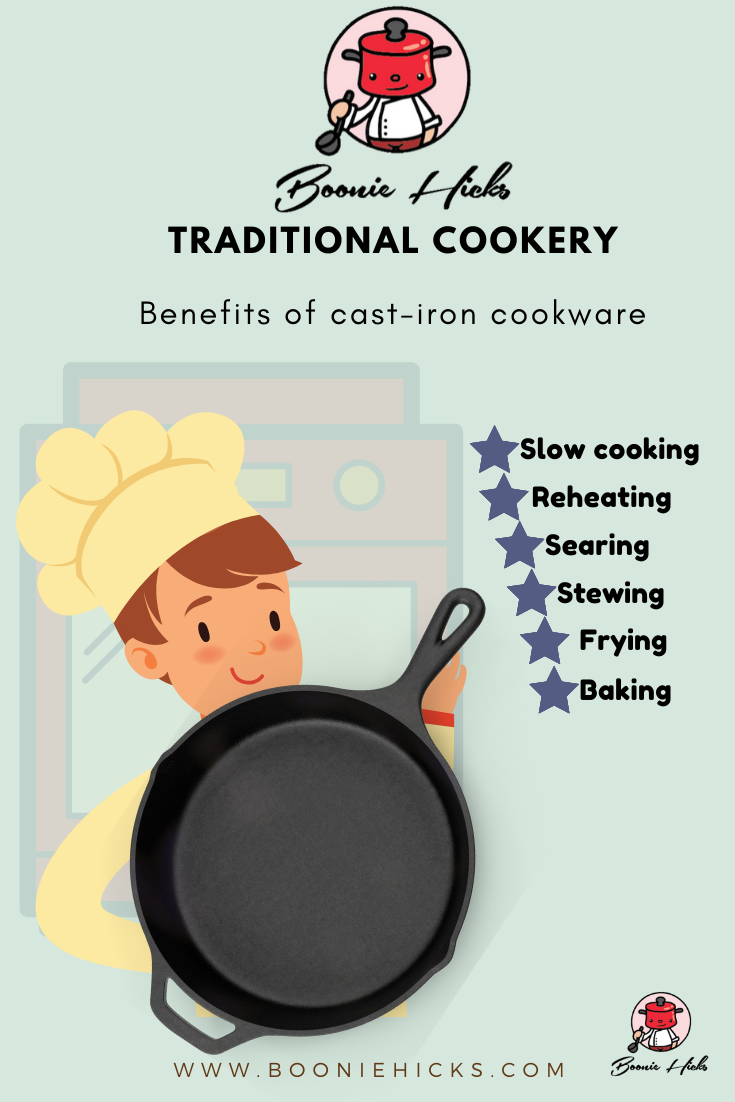
You can use cast iron cookware on the following:
- Gas
- Electric
- Glass (please be careful, it may scratch like any other cookware).
- Induction
- Wood burning stoves
- Cooking on barbecues, campfires, and hot coals.
It is good practice is to heat cast iron slowly before raising the temperature. Modern cookers can heat very quickly, and this sudden temperature rise may warp your cast iron cookware.
The handle gets hot.
This one is not really a surprise. The design for modern cast iron skillets hasn’t really changed over the last 150 years. The handle is still cute stumpy, the same as it was all those years ago.
Usually, I’m able to cook meals before the handle gets too hot to handle. However, if the pan is too hot, simply use an oven mitt or tea towel.
Lodge also has specifically designed handle holders that fit snugly onto your skillet. They really stop the heat well. The Lodge Handle holders are available on Amazon and come in the popular silicone (affiliate link) and cotton with lining (affiliate link) like mine pictured. With all cookware, consideration may be needed with young children. Small disadvantage.
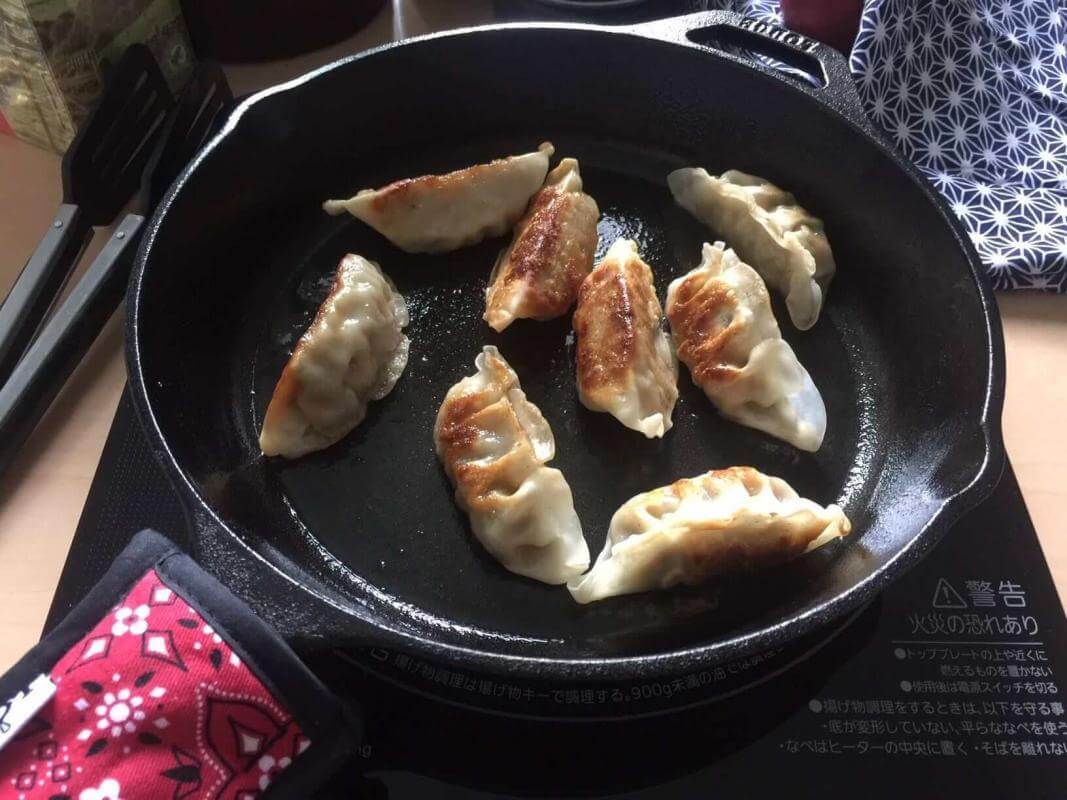
Cast iron is heavier than other cookware.
It really can be rather weighty. Bodybuilders pump iron for a reason. The older pans, such as Erie, made pans are lighter like many of the vintage pans. However, they are often pricey because of their collectability. The older pans are also more prone to warping and bowing because the casting was thinner.
The high-quality French enamelware such as Le Creuset is just as heavy, and Staub is slightly heavier again. Lodge cast iron offers a good balance in weight, especially if you’re looking at a large dutch oven. Big Staub cocottes may be too heavy for many uses. Con.
Cooking acidic foods.
I grab my skillet nearly every time. However, when boiling liquid, I turn to enameled hollowware or stainless steel. Food may be tainted and discolored by the seasoning if you cook acidic food for a long time. It may also lift off that lovely seasoning that makes the skillet or Dutch oven so non-stick and easy to clean.
Highly acidic foods are also not recommended for cast iron, for example, tomato-based sauces. However, this is not to say you can’t fry some tomatoes with your fried eggs and bacon. As long as you have a nicely seasoned pan, you’ll cook yourself a great breakfast.
The acidity in food lifts the seasoning from your pan. And increases the amount of iron in the food. Food may taste tainted from a large amount of naturally released iron when cooking highly acidic food. Minor Inconvenience.
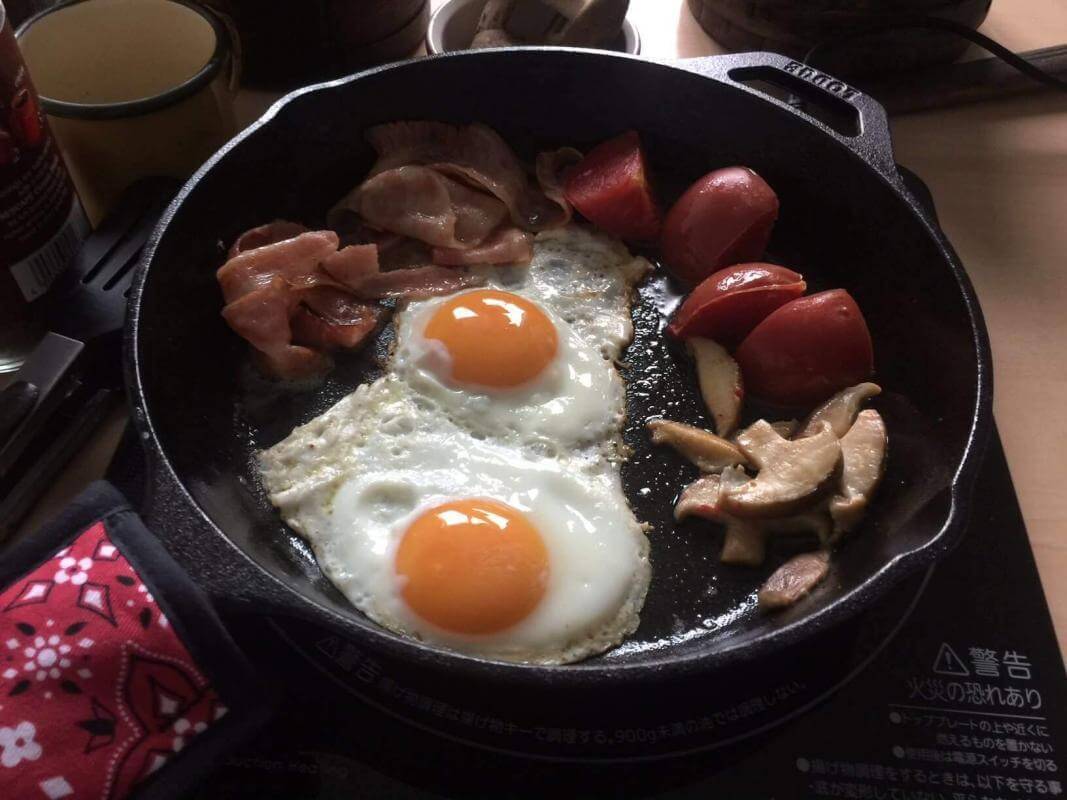
Bare cast iron may require seasoning.
Cast iron may need re-seasoning if being over-zealous with the use of soap and scouring pads. Firstly this is not difficult (wipe the pan with a small amount of oil, then place in the oven and set on high heat).
Seasoning makes cast iron cooking surface semi-nonstick. However, seasoning is not needed for enameled cast iron and other cookware. So re-seasoning is both an advantage and a disadvantage.
Is cast iron cookware for you?
I think the pros outweigh the cons, and you’ll be hard-pressed to find a better safe cooking surface.
If you are looking for a new piece of cookware, cast iron will do you proud for years, if not decades.
I highly recommend Lodge Manufacturing if you are thinking of purchasing bare cast iron. And if you’re wondering. Yes, I cook with a Lodge 10.25 inch skillet. It also seems a lot smoother than many other makers. And they come at a great price and are easy to use.
Lodge makes excellent cast iron. They are still an American family business and have supported the local community of South Pittsburg in Tennessee.
If you want to read why the Lodge 10.25inch pan is the best all-around skillet, please click the link.
Cheers, happy cooking.

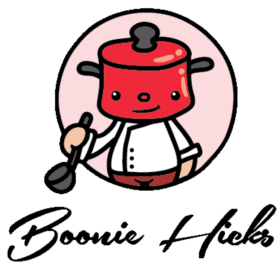
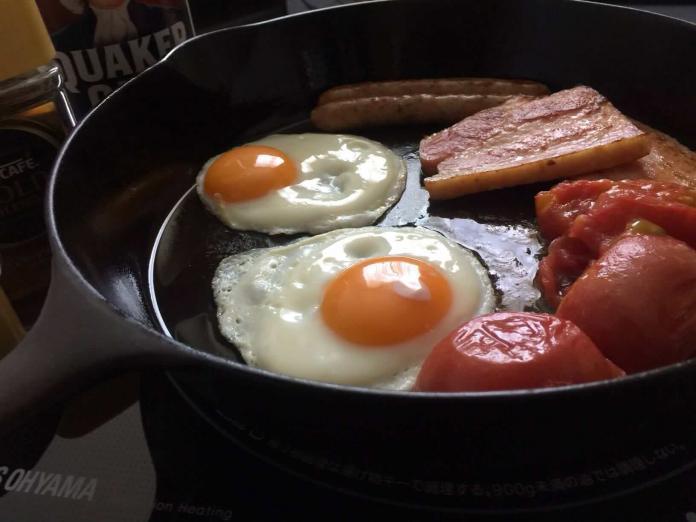
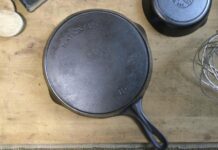
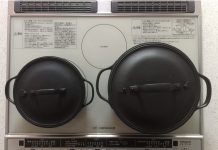
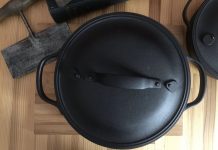



Hello, I enjoyed reading your guides on cast ion cookware.
I want to use a cast iron pot, Lodge. However, I am too scared to cook a nice meal if the pan has rust.
First of all, if the food gets rusty, how bad is this? I have read some reviews of people saying their cast iron pre-seasoned saucepans got rusty during cooking. Even though it was a Lodge or other well-known brands.
My second question is, how often do we need to season it in the oven, after every 3rd use?
Lastly, I tried the Amazon Basic cast iron saucepan. It was darker than the Lodge skillet. I reseasoned it to be on the safe side. But when I fried an egg, it tasted really bitter. Did I use too much oil, or perhaps, the manufacturer’s seasoning on the saucepan caused a burnt bitter taste?
Thank you for your time.
Hello Ay, I’m so happy you’ve enjoyed reading the articles.
I can understand the reluctance to use cast iron cookware from the reviews you’ve read online. However, Lodge Manufacturing is a good brand, and I believe you’ll be happy with its cookware.
New cast iron has a thin layer of seasoning, so I recommend building it up before cooking fish or acidic foods. Many cast iron enthusiasts like to cook food with a lot of fat, such as bacon, for the first few uses. After cleaning it just wipe it out with a paper towel. I like cooking hash browns to build seasoning. They have a lot of oil, and the pan will require no scrubbing.
Just keep on using your pan, and you won’t have to reseason it. This is why there is a no soap debate when cleaning cast iron. Just rub a little oil into the pan after use to prevent rust.
Try cooking room temperature eggs and on low heat. Cast iron takes a little getting used to. I suspect the bottom of the egg was cooked before the top.
Cast iron cookware is fun but each pan has a unique personality.
Cheers happy cooking
How do you salvage a skillet that has been put thru a cycle in the dishwasher?
Hi Linda
It sounds like you have every cast-iron collector’s nightmare.
I hope it hasn’t developed any flash rust after the cycle. You will need to scrub your pan with an SOS pad if it has. Then reseason your pan with your favorite oil. If the pan has patches of seasoning remaining, I wouldn’t worry about it, as it will fill in overtime.
Reasoning a pan sounds like a fun weekend project. Just remember to keep your windows open to avoid a smoky kitchen.
Good luck.
I have loved cast iron cooking since I began cooking, around 45 years ago. I own a set of Le Creuset, but I still prefer and use my old cast iron pans. I enjoyed your blog and had some old memories revived! Thank you.
Hi Meggie
Thanks for your kind words, I’m really pleased you enjoyed exploring the site, and it brought back fond memories of using vintage pans. Your lucky to have a set of Le Creuset. They are fine pots, and so much lighter compared to other brands.
Glad to hear you get so much enjoyment from your pans.
Cheers Meg
This might seem like a dumb question but what does the number 8 or 9 mean on an iron skillet? Does that mean it’s 8 inches or 9 inches wide? Thanks in advance.
Hi Alisa
Thanks for getting in touch, and it’s frequently asked question.
You’re right the numbers on skillets indicate size. However, the size number is in reference to use on coal and wood ranges. Old cookers had different sized elements that skillets would slot into prevent movement. The numbers were to select the correct size pan with the correct element. In later years numbers were more symbolic with the development of modern gas and electric cookers, but it remained a popular way to indicate the size of the skillet.
Hope this helps
Thank you. Your contrasting information won the day. I stumbled across this site after I returned a rather expensive set; Green pan Diamond Craft cookware. I’m too simple I guess, but the value was $450-$570 and the last thing I want to do is worry about using and damaging a set of cookware for the sake of cooking dinner.
Judging by the reviews of other folks, cast iron will cook food just fine. And just for the record SurLaTab knows ya know. What I can’t wrap my mind around is? Why I reached further than what I can grasp.
Respectfully at your Service, Spider
Hi Spider
Thank you for your kind words and I’m so pleased you found the information useful. I’m sure the good people at Sur la Table and Green pan understand their cookware is out the reach for many budding chefs at this moment. But I’m sure their cookware is hard to beat and I’m humbled if they know of my little hobby blog.
Cast iron cookware has great thermal density and will cook up a storm in the kitchen. It takes little longer to warm up but you still can’t beat a good old fashioned cast-iron skillet for a full English breakfast. Easier on the pocket too.
Cheers Spider